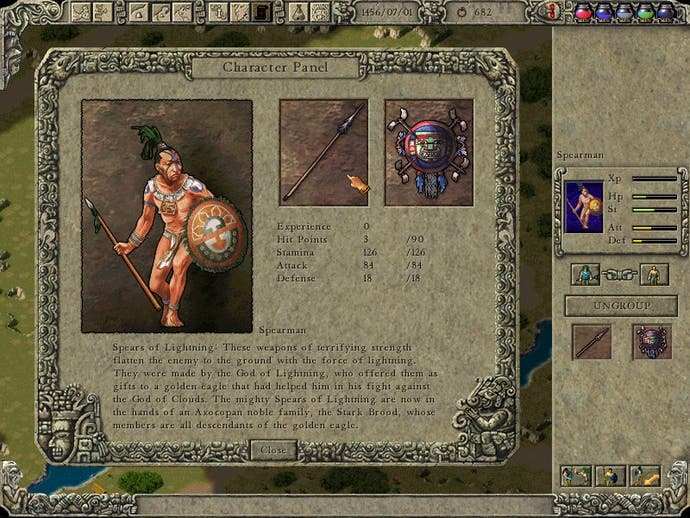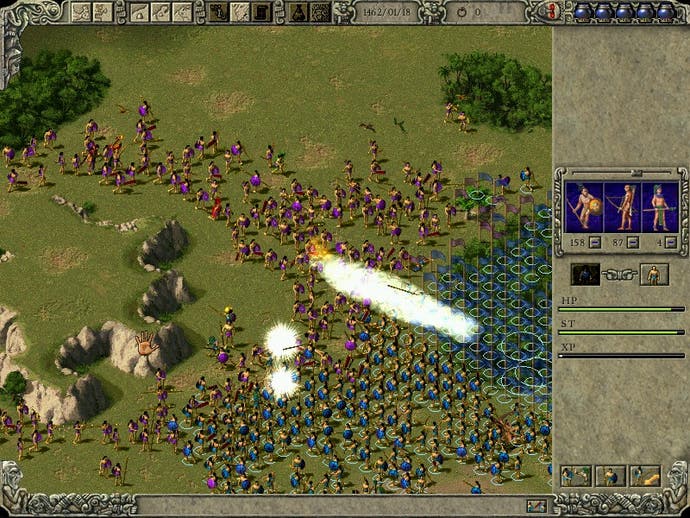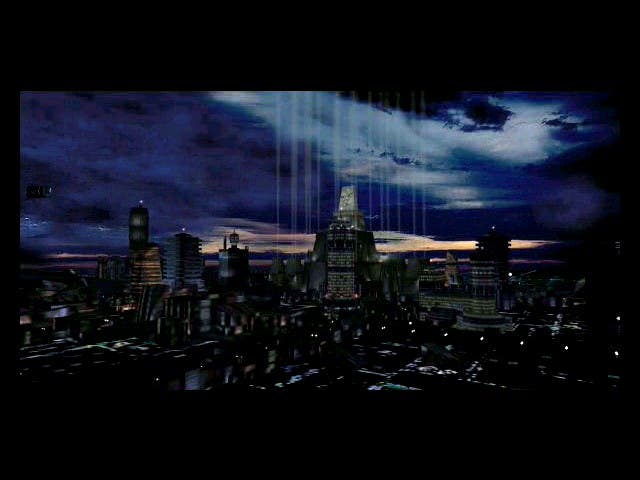Theocracy
Aztec strategy game reviewed

The Chronicles
Ancient Aztec legends spoke of a day when the great feathered serpent god Quetzacoatl would return from across the Atlantic Ocean. Unfortunately for the people of medieval Mexico, it was actually the Spanish who arrived on their coast in the early 16th century, and promptly set about reducing the entire Aztec empire to ruins and slaughtering most of its population...
Now Theocracy gives you a chance to rewrite history, starting at the beginning of the 15th century as the ruler of a small Aztec province and building yourself an empire capable of fighting off the Spanish when they arrive a hundred years later.
To get you started there are a series of seven short missions known as "Chronicles", each teaching you how to manage a particular part of the game, from basic troop selection and movement to tactics and economics. Each is accompanied by a short tutorial movie which shows you all the controls you need to accomplish the tasks you have been set.
There is also an eighth Chronicle, "The Revolt", which sees you putting together everything you have learnt so far to free your people from the empire which has occupied your homeland. It all makes for an easy introduction to the game, whether you are an experienced strategy gamer or a hardened Hearts addict.
So far so Age of Empires, but whereas most strategy games would comfortably slide into a linear series of "build a base, kill the enemy" type missions at this point, Theocracy is just warming you up...

The Prophecy
The main part of the game is The Prophecy, which gives you the whole of Mexico as your playing field, and an open-ended campaign that can last for well over a century!
The map of Mexico is split into over forty seperate territories, a little like the classic board game Risk. You start the game with just a single province, a small army, and a few dozen untrained workers to serve you, but from here on in you can essentially do whatever you want. There are a few missions which will crop up along the way to prod you in the right direction, but it's entirely up to you if and when you carry them out.
Right click on your province and you will go to the familiar real time strategy view seen in the Chronicles part of the game. From here you can assign your men to construct new buildings or to work in existing structures, and so gradually build up your economy and military.
Once you have assembled a sizeable army you simply erect a camp for your troops and move any units you want to take with you into it. Then go back to the map of Mexico, select the marker that represents the troops you have just transferred, and then right click on their destination.
The cunning bit is that while you are looking at a particular province, time stands still. You can spend as long as you like assigning orders to all your various units, but until you go back to the main map and unpause the game nothing will get built, no troops will be trained, and you don't have to worry about an enemy invading one of your provinces while you are busy elsewhere.
This mix of real time and turn based strategy means that Theocracy takes place on a far larger canvas than a purely real time game ever could. Events never overtake you, as you can always pause the game at any point and spend as much time as you like building the perfect city and micro-managing your work force and economy in individual provinces without worrying about what your enemies are up to.
You can also automate parts of the game. Can't be bothered managing all forty provinces by hand? Simply pay a governor for each territory you don't want to micro-manage and tell them how to split the available work force between various jobs. Don't want to fight a battle the hard way? Just select "Emulate", and the computer will work out the final result for you almost instantly.

The Art Of War
There are a wide range of buildings available, from farms and ranches to vast pyramid temples and barracks, and from lumberyards and fishing huts to schools and hospitals.
And as the game progresses you will discover a few new buildings and units through special missions. Invade one of your neighbours at the beginning of the game and you will discover the llama. Team up a llama master and his herd of animals with a trader and you can transport goods between your territories, something that is essential as few regions have any source of gold, jade, or stone.
Military units are rather more limited though - you only have a choice of spearmen, swordsmen and archers at the beginning of the game, later joined by spear throwing machines and trained jaguars. You can also train five different kinds of priest in the appropriate temples, and each type has four unique spells, plus two more which they gain on becoming head priests.
To make things a little more interesting, soldiers gain experience as they fight in battles, and there are a wide range of magical weapons, shields and other items which you can discover during the game and give to your best troops.
You can also give a group of soldiers a leader and then assemble them into formations, moving the entire group simply by selecting their leader. Not only are there five default formations to choose from, but you can also create your own formations from scratch using a chessboard-style editor within the game.
Unfortunately once you get your troops into battle things can become a little chaotic. Combat is entirely real time, and there is no way to slow down or pause the action while you give orders. Formations tend to be a little inflexible and difficult to maneuver in the heat of battle, and I often resorted to ungrouping my men before attacking simply because they are more responsive that way. Which is a shame...

Technology
Theocracy might not be ground-breaking when it comes to its technology, but it just proves that you don't need a fancy 3D accelerated graphics engine and positional surround sound audio to make a good game. Things can get a little slow towards the end of the game on older systems, as battles can involve anything up to a thousand troops, but generally the engine does a good job of keeping things moving at a reasonable pace.
The unit sprites are beautifully detailed and nicely animated, as well as being very easy to identify. The buildings are big and colourful, and more than a match for those in Age of Empires. Even the interface is well thought out and looks great.
Philos also deserve a big round of applause for the cutscenes, which are truly excellent and all done in-house. The final cinematic after you defeat the Spanish adds a wonderful twist to the end of the game, showing you the world of today ruled by Aztecs.
The sound effects are also top notch, from the cutting of wood and ambient sounds of the forest to the clamour of battle, although they can get a little repetitive after several hours of play.
The music is good as well, but unfortunately it is only in the form of CD audio. The game has a nasty tendency to switch tracks every time you move between the province and main maps in the Prophecy, resulting in a short but annoying pause in the game as the CD skips.

Conclusion
Theocracy is a truly massive game - playing through the Prophecy can easily swallow a week or more of your life, and I have barely scratched the surface with this review...
It may sound like a cliche, but you really do need to play the game for yourself to fully appreciate it. Combat is a little disappointing compared to more traditional real time strategy games, and the trade system could have been a little easier to manage, but the sheer scale of the game and the wealth of options and strategies available makes up for any minor niggles.
Developers Philos set out to combine the best parts of Command & Conquer and Civilization, and they have come very close to hitting the mark.

